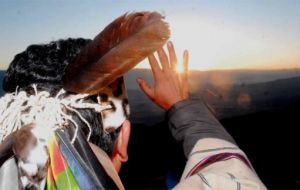MercoPress. South Atlantic News Agency
Andes Aymaras celebrate arrival of winter solstice and New Year 5517
 Thousand waited for the first morning Tata Inti rays in Tiwanaku, at the beginning of the solstice.
Thousand waited for the first morning Tata Inti rays in Tiwanaku, at the beginning of the solstice. With hands extended towards the blue sky and at six Celsius below zero, thousands gathered on June 21st to receive the first sun rays from Tata Inti (Sun God) in Tiwanaku, Bolivia, in coincidence with the celebration of the winter solstice in the Southern hemisphere which signals the beginning of New Year Aymara 5517.
People arrived at the open shrine of Kalasasaya seeking impregnation of astral energy, while tributes to the Sun God burnt in pyres giving the scenery an atmosphere of solemnity and mysticism full of rituals and ancestral esoteric symbols.
The hub of Andean ceremonies, Kalasasaya lodges chamanes, kallaguayas, achachilas and amautas (sage and mystic Indians), together with thousands of aymaras and quechuas (Andean Indians) plus a small number of Europeans.
Previously the amautas mounted a pyre where they deposited a table with tributes to Tata Inti with the purpose of asking favours for a good crop, plus peace and prosperity for Bolivia and wisdom for elected President Evo Morales, who belongs to the Aymara group.
A gift of incense and copal was lit as the first rays of the sun emerged at 3.800 metres of altitude in the Tiwanaku, while flames from the bonfire tried to scare the freezing cold of the early Andes morning.
Hours before the solstice ceremony Aymaras made an offering or wajtha to Pachamama (mother Earth) at the close of the year. A mallku (dignified sage chief) delivered a tribute which was made up of coke (the sacred Andean leaf), liqueurs, sweets, incense and copal.
A visiting Indian from the mapuche ethnic along the southern coast of Chile present at the ceremony as a special ambassador said she “was hopeful that with the New Year indigenous peoples could be finally recognized, and governments would see with clarity the reality we are living as Indigenous peoples and as Latinamerican countries”.
The farewell ritual for outgoing 5516 and the festivity for the advent of 5517 begun early Saturday morning in the Kimsachaca knoll, lasted all night at the Lloco, Lloco hill and concluded with the arrival of the solstice on Sunday at the open field of Kalasasaya.
For the Aymaras the solstice is seen as the moment the Sun begins to approach Mother Earth, as well as the beginning of the agriculture year.




Top Comments
Disclaimer & comment rulesCommenting for this story is now closed.
If you have a Facebook account, become a fan and comment on our Facebook Page!